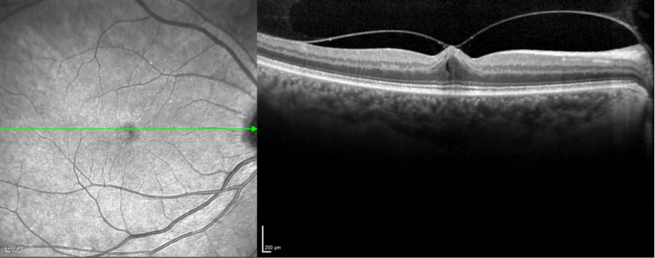Article
#18: Enzymatic Vitreolysis with Ocriplasmin
While many previous efforts had been made to develop a pharmacologic agent that promoted enzymatic vitreolysis, ocriplasmin was the first to induce both synchesis and syneresis without adversely affecting the retina.
Ocriplasmin (trade name: Jetrea(R)) is a truncated form of the human serine protease plasmin that has proteolytic activity against fibronectin and laminin, two major components of the vitreoretinal interface. It was approved by the U.S. Food and Drug Administration for the treatment of symptomatic vitreomacular adhesion (VMA) in October 2012.
While many previous efforts had been made to develop a pharmacologic agent that promoted enzymatic vitreolysis, ocriplasmin was the first to induce both synchesis and syneresis without adversely affecting the retina.
In clinical trials, intravitreal injection of ocriplasmin led to resolution of vitreomacular traction, induction of posterior vitreous detachment, and closure of a macular hole in some patients. In these trials, the majority of responders demonstrated resolution of VMA by day seven, and all did so by day 28.
There are currently two primary patient groups who receive ocriplasmin:
- Patients with mild-to-moderate symptomatic VMA and good visual acuity (20/40 or better on a Snellen visual acuity chart), especially those whose professional responsibilities require heavy amounts of reading or detailed visual tasks. Because these patients have good baseline vision, vitrectomy surgery would typically not be indicated due to potential adverse events.
- Patients with moderate VMA whose visual acuity has deteriorated to 20/80 or worse. These are patients who would otherwise typically require vitrectomy but now are often offered ocriplasmin as front-line therapy.

OCT image of patient with vitreomacular traction acquired with SPECTRALIS(R).Symptomatic VMA, typically diagnosed through use of optical coherence tomography, is thought to affect approximately 3.5 of every 1000 individuals. According to an international study group,1 its diagnosis requires the presence of the following on at least one OCT B-scan image:
- Partial vitreous detachment as indicated by elevation of cortical vitreous above the retinal surface in the perifoveal area.
- Persistent vitreous attachment to the macula within a 3-mm radius from the center of the fovea.
- Acute angle between posterior hyaloid and inner retinal surface.
- Presence of changes in foveal contour or retinal morphology (distortion of foveal surface, intraretinal structural changes such as pseudocyst formation, elevation of fovea from the RPE, or a combination of any of these three features).
- Absence of full thickness interruption of all retinal layers.
Reference
1. Duker JS, Kaiser PK, Binder S, et al. The International Vitreomacular Traction Study Group Classification of Vitreomacular Adhesion, Traction, and Macular Hole. Ophthalmology. 2013:1â9.
Newsletter
Don’t miss out—get Ophthalmology Times updates on the latest clinical advancements and expert interviews, straight to your inbox.




